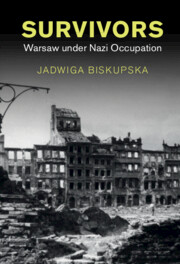Book contents
- Survivors
- Maps
- Studies in the Social and Cultural History of Modern Warfare
- Survivors
- Copyright page
- Dedication
- Contents
- Figures
- Acknowledgments
- Introduction
- 1 Warsaw Besieged
- 2 The Killing Years
- 3 Pawiak Prison
- 4 The Warsaw Ghetto
- 5 Information Wars
- 6 School of Hard Knocks
- 7 Matters of Faith
- 8 Spoiling for a Fight
- 9 Home Army on the Offensive
- Conclusion
- Bibliography
- Index
8 - Spoiling for a Fight
Armed Opposition
Published online by Cambridge University Press: 27 January 2022
- Survivors
- Maps
- Studies in the Social and Cultural History of Modern Warfare
- Survivors
- Copyright page
- Dedication
- Contents
- Figures
- Acknowledgments
- Introduction
- 1 Warsaw Besieged
- 2 The Killing Years
- 3 Pawiak Prison
- 4 The Warsaw Ghetto
- 5 Information Wars
- 6 School of Hard Knocks
- 7 Matters of Faith
- 8 Spoiling for a Fight
- 9 Home Army on the Offensive
- Conclusion
- Bibliography
- Index
Summary
Chapter 8, “Spoiling for A Fight: Armed Opposition,” begins a two-part examination of violent resistance and how, when, and why Poles embraced or rejected it. This discussion is deliberately postponed in the story, as much of the existing literature focuses on military resistance as a shorthand for resistance as a whole, which it was not. Polish military resistance efforts, initially launched by officers and soldiers of the Polish Army in hiding under occupation, remained fractured and hamstrung by vicious Nazi reprisals until 1942. Despite its danger, myriad groups organized around plans for insurrection, spanning the political spectrum from orthodox communists to the fascist far right, and including Polish-Jewish participation. After the destruction of many such initiatives and the merging and reformation of others, one increasingly grew in size and strength: the Home Army (Armia Krajowa) eventually dominated a chaotic resistance landscape through the support of the Western Allies. This chapter argues that violent resistance was initially a disorganized catastrophe, and only late in the occupation did a few surviving underground militaries achieve the ability to influence the Polish population or threaten the German occupiers.
Keywords
- Type
- Chapter
- Information
- SurvivorsWarsaw under Nazi Occupation, pp. 226 - 253Publisher: Cambridge University PressPrint publication year: 2022

